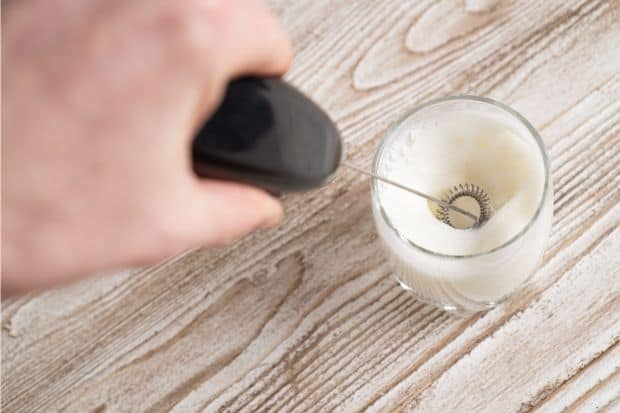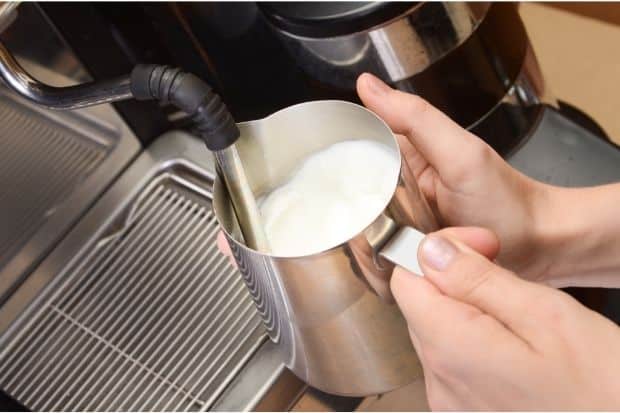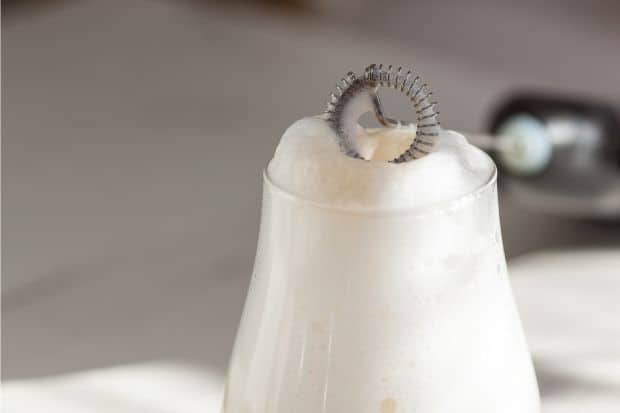Just so you know, as an Amazon Associate we earn from qualifying purchases made via bold red links, buttons or images.
Last Updated on December 6, 2023
I like a good cappuccino, so if I were ever to adopt a vegan diet, one of my first questions would be, “Can you froth almond milk?”
And if not, then which non-dairy milks can you froth for your coffee drink?
We decided to try out as many milks as we could get our hands on, and find out which ones froth the best. Here are the froth ratings for all the milks we tested:
| Type of milk | Froth rating |
|---|---|
| 2% milk | 10/10 |
| Almond milk | 9/10 |
| Half-and-half | 8/10 |
| Oat milk | 7/10 |
| Coffee creamer | 7/10 |
| Coconut milk | 4/10 |
| Chocolate milk | 3/10 |
| Heavy cream | 3/10 |
| Soy milk | 1/10 |
| Cashew milk | 0/10 |
Yes, you can froth almond milk, and you’ll also do pretty well with half-and-half, oat milk or coffee creamer. After that, it gets a bit dicey.
We’ll show you our demonstration videos below and lay out the nutritional information for each milk we tried frothing, but first let’s talk a bit about the science of milk frothing.
What Makes Milk Froth?

Milk, including most non-dairy milk, has four main components:
- water
- protein
- fat
- carbohydrates
Frothing milk for coffee fundamentally involves aeration—adding air into liquid. Some frothing methods do this by agitation, which is what happens when you froth milk by hand using a whisk, shake it in a mason jar, or use an immersion blender. Other frothing methods do it by injection, like when you use the steam wand on an espresso machine. Learn the differences between a milk frother vs. a steamer here.

No matter whether you use agitation or injection, air and water don’t mix every well. The froth would destabilize and fall apart quickly if you didn’t have those proteins in the milk. They act as stabilizers.
The proteins do their job at the interface where liquid meets gas—where the water in the milk meets the air. The important proteins are called casein proteins. In milk, they take the form of little spheres known as micelles. Aeration causes the micelles to break up. The casein proteins suddenly need something else to latch onto. So they form a protective layer around the air bubbles, keeping the bubbles stable and allowing the milk to foam.
This is all explained by an actual scientist in this video, if you’ve got 24 minutes:
Meanwhile, the fat in the milk acts as a destabilizer. The good news is, when the temperature rises, the fat melts and doesn’t destabilize things as much. So you can find a nice balance by heating your milk when you froth it. With cold milk, the milk froth disappears more quickly.
So in any type of milk, the protein and fat content will determine the quality of the foam. Whole milk gets you a thicker, creamy texture and a more stable foam, while skim milk gets you a drier, more voluminous foam with larger bubbles. The first kind will mix better with coffee, which is why coffee shops use it as the base for steamed milk to create latte art.
Protein and Fat Content of Dairy vs. Non-Dairy Milk
We tested 10 kinds of milk, and their protein and fat content varied widely.
For our baseline regular milk, we used 2% (partly skimmed) milk. It had nine grams of protein per cup (250 mL), and five grams of fat.
Our non-dairy milks ranged in protein from less than one gram per cup (cashew milk) to eight grams per cup (soy milk). For fat content, cashew milk was lowest at 2.1 grams per cup and coconut milk was highest at a whopping 42.4 grams per cup.
How We Tested
We used a Nespresso Aeroccino milk frother for our testing. This electric device uses a combination of heat and agitation to froth milk. A heating element inside the device heats the milk in the frothing chamber while a tiny whisk in the bottom of the chamber agitates and aerates the milk.
We filled the device with approximately 240 mL of each milk product and ran the Aeroccino for 90 seconds to froth it, using the same process consistently for each milk.
Now let’s get to your burning questions about milk frothing.
Can You Froth 2% Milk?
Yes, you can froth 2% milk. We figured as much, which is why we used it as our baseline for this testing. It formed a supple foam with good body that seemed quite stable even after we dropped it on top of hot coffee. As this is the milk by which all others were to be measured, we gave it a 10/10 on our scale.
| Froth rating | 10/10 |
| Protein per 250mL | 9 grams |
| Fat per 250mL | 5 grams |
| Carbohydrates per 250mL | 12 grams |
| Brand | Island Farms |
Can You Froth Almond Milk?
Yes, you can froth almond milk. In our test it produced a nice almond milk froth that was not far in quality from regular 2% milk. We would happily top our coffee with a dollop of frothed almond milk.
| Froth rating | 9/10 |
| Protein per 250mL | 1 gram |
| Fat per 250mL | 2.6 grams |
| Carbohydrates per 250mL | 1 gram |
| Brand | Silk, unsweetened |
Can You Froth Half and Half?
Yes, you can froth half and half. While the foam was somewhat looser and seemed to spread out a bit more upon contact with the hot coffee, it certainly held its own. An espresso or lungo topped with slightly fatty, frothed half-and-half is a pretty nice beverage, actually. They call it a caffe breve.
| Froth rating | 8/10 |
| Protein per 250mL | 8.3 grams |
| Fat per 250mL | 25 grams |
| Carbohydrates per 250mL | 16.7 grams |
| Brand | Dairyland |
Can You Froth Oat Milk?
Yes, you can froth oat milk. It surprised us by producing a fairly supple foam that spooned nicely on top of the coffee and held together reasonably well once it got there.
| Froth rating | 7/10 |
| Protein per 250mL | 2.1 grams |
| Fat per 250mL | 7.3 grams |
| Carbohydrates per 250mL | 15.6 grams |
| Brand | Califia Farms |
Can You Froth Coffee Creamer?
Yes, you can froth coffee creamer. You’re getting a bit decadent here with a cream that comes in at 18 per cent fat, in comparison with the 10 per cent of half-and-half. But it still forms a reasonably nice foam that will rest on the surface of your coffee and taste quite rich.
| Froth rating | 7/10 |
| Protein per 250mL | 6.8 grams |
| Fat per 250mL | 42 grams |
| Carbohydrates per 250mL | 16.7 grams |
| Brand | Lucerne |
Can You Froth Coconut Milk?
No, you cannot froth coconut milk. God knows we tried. Coconut milk is so thick that the whisk inside our Aeroccino would barely stir it at first. It eventually got spinning at a good clip and did generate something resembling froth, but it was thin in consistency and wouldn’t really stack up on the surface of the coffee.
| Froth rating | 4/10 |
| Protein per 250mL | 3 grams |
| Fat per 250mL | 42.4 grams |
| Carbohydrates per 250mL | 15.2 grams |
| Brand | Tropic Isle |
Can You Froth Heavy Cream?
No, you cannot froth heavy cream. We used Dairyland whipping cream which is pretty much the same thing. It started out a bit like the coconut milk, providing a lot of resistance to the whisk in our Aeroccino. But even once it got going, it didn’t froth enough to properly spoon onto the top of our coffee.
| Froth rating | 3/10 |
| Protein per 250mL | 5 grams |
| Fat per 250mL | 83.4 grams |
| Carbohydrates per 250mL | 0 grams |
| Brand | Dairyland |
Can You Froth Chocolate Milk?
No, you cannot froth chocolate milk. Even thought it’s much thinner and easier to agitate than coconut milk or heavy cream, it just doesn’t really build up much body. Yes, there were bubbles and it kind of looked like froth, but it was disappointingly runny.
| Froth rating | 3/10 |
| Protein per 250mL | 8 grams |
| Fat per 250mL | 2 grams |
| Carbohydrates per 250mL | 24 grams |
| Brand | Island Farms |
Can You Froth Soy Milk?
No, you cannot froth soy milk at all. All we got were tiny little bubbles dotting the surface of the milk, which basically came out of the frother with the same consistency it had going in. Strangely, its protein content and fat are in the same ballpark as 2% milk, so we’re not sure what its problem was.
| Froth rating | 1/10 |
| Protein per 250mL | 8 grams |
| Fat per 250mL | 4.5 grams |
| Carbohydrates per 250mL | 4 grams |
| Brand | Silk |
Can You Froth Cashew Milk?
No, you cannot froth cashew milk. It froths even worse than soy milk. The only difference is that the bubbles dotting the surface were a lot bigger, but they were not stable at all. We put this down to cashew milk being by far the lowest-protein milk in our test.
| Froth rating | 0/10 |
| Protein per 250mL | <1 gram |
| Fat per 250mL | 2.1 grams |
| Carbohydrates per 250mL | 1 gram |
| Brand | Silk, unsweetened vanilla |
Milk Frothing FAQ
Why froth milk?
Frothed milk changes the consistency of your coffee—particularly at the surface where your taste buds encounter it. This physical change alters the biochemical interplay between your tongue and the beverage, contributing to flavor. You might be surprised that a physical difference would result in such a taste difference, but try tasting a coffee topped with big-bubble dry foam, followed by a coffee with tiny-bubble silky foam, and you will notice a remarkable difference in flavor.
Frothed milk also acts as a sort of insulation, keeping heat trapped within the coffee so that it stays hot longer.
Finally, you can’t make latte art with unfrothed milk!
Do you froth milk before or after coffee?
Whether you froth milk before or after brewing your coffee depends on your equipment. A single-boiler espresso machine requires you to pull the shot first, then wait for the machine to rise to steaming temperature. Dual-boiler and heat-exchange machines let you to steam and brew in quick succession.
So if you can do them close together, which should you do first? Baristas debate this. Some insist that milk must be added within 10 seconds of brewing the espresso, so in that case you’d have to froth first and then let the milk sit while you brew. But others argue that it’s easier to work with an espresso shot that’s been sitting for a minute than with milk that’s been sitting, so they do it the other way around. Try both and see what works for you.
Should you froth milk hot or cold?
It’s better to froth milk hot than cold, because high temperatures break down the fat in the milk that destabilizes air bubbles. Warmer milk will allow for tighter, more consistent bubbles that hold their shape for longer.
Is milk foam bad for you?
Milk foam is just as healthy as the milk you use for frothing. The ingredients—water, protein, fat and carbohydrates—remain the same after frothing, they’re just arranged slightly differently. Frothing the milk produces no ill health effects.


